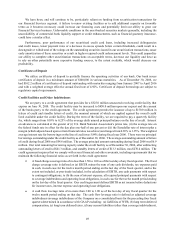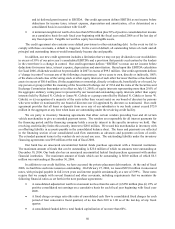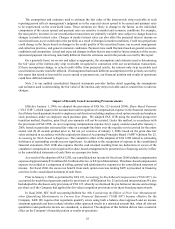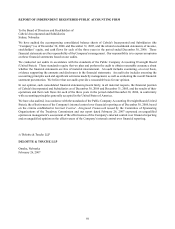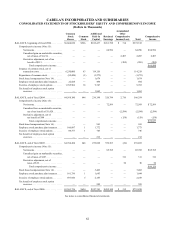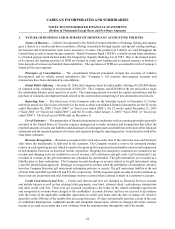Cabela's 2006 Annual Report Download - page 59
Download and view the complete annual report
Please find page 59 of the 2006 Cabela's annual report below. You can navigate through the pages in the report by either clicking on the pages listed below, or by using the keyword search tool below to find specific information within the annual report.55
The assumptions and estimates used to estimate the fair value of the interest-only strip receivable at each
reporting period reflects management’s judgment as to the expected excess spread to be earned and payment rates
to be experienced on the securitized loans. These estimates are likely to change in the future, as the individual
components of the excess spread and payment rates are sensitive to market and economic conditions. For example,
the rates paid to investors in our securitization transactions are primarily variable rates subject to change based on
changes in market interest rates. Changes in market interest rates can also affect the projected interest income on
securitized loans, as we could reprice the portfolio as a result of changes in market conditions. Credit loss projections
could change in the future based on changes in the credit quality of the securitized loans, our account management
and collection practices, and general economic conditions. Payment rates could fluctuate based on general economic
conditions and competition. Actual and expected changes in these factors may result in future estimates of the excess
spread and payment rates being materially different from the estimates used in the periods covered by this report.
On a quarterly basis, we review and adjust as appropriate, the assumptions and estimates used in determining
the fair value of the interest-only strip receivable recognized in connection with our securitization transactions.
If these assumptions change, or actual results differ from projected results, the interest-only strip receivable and
securitization income would be affected. If management had made different assumptions for the periods covered by
this report that raised or lowered the excess spread or payment rate, our financial position and results of operations
could have differed materially.
Note 2 to our audited consolidated financial statements provides further detail regarding the assumptions
and estimates used in determining the fair value of the interest-only strip receivable and its sensitivities to adverse
changes.
Impact of Recently Issued Accounting Pronouncements
Effective January 1, 2006, we adopted the provisions of FAS No. 123 (revised 2004), Share-Based Payment
(“FAS 123R”), which requires the measurement and recognition of compensation expense in the financial statements
for all share-based payment awards to employees and directors including employee stock option awards and employee
stock purchases under an employee stock purchase plan. We adopted FAS 123R using the modified prospective
transition method, therefore, prior fiscal year amounts will not be restated. Under this method, in accordance with
the provisions of FAS 123R, we are recognizing compensation expense for (i) equity awards issued after January 1,
2006, based on grant date estimated fair value on a straight-line basis over the requisite service period for the entire
award, and (b) all awards granted prior to, but not yet vested as of January 1, 2006, based on the grant date fair
value estimated in accordance with the original provisions of Accounting Principles Board (“APB”) Opinion No. 25,
Accounting for Stock Issued to Employees. The cumulative effect of the adoption of FAS 123R related to estimating
forfeitures of outstanding awards was not significant. In addition to the recognition of expense in the consolidated
financial statements, FAS 123R also requires that the cash retained resulting from tax deductions in excess of the
cumulative compensation cost recognized for share-based arrangements be presented as a financing activity inflow
in the consolidated statements of cash flows on a prospective basis.
As a result of the adoption of FAS 123R, our consolidated net income for fiscal year 2006 includes compensation
expense of approximately $3.6 million ($2.3 million after-tax, or $.03 per diluted share). This share-based compensation
expense is recorded as a component of selling, general and administrative expenses in the consolidated statement of
income. For fiscal 2006, the excess tax benefit from stock option exercises totaling $495 is presented in financing
activities in the consolidated statement of cash flows.
Prior to January 1, 2006, as permitted by FAS 123, Accounting for Stock-Based Compensation (“FAS 123”), we
accounted for stock-based payments under the provisions of APB Opinion No. 25 and related interpretations We also
had adopted the disclosure-only provisions of FAS 123, whereby we disclosed the pro forma net income and earnings
per share as if the Company had applied the fair value recognition provisions to its share-based payment awards.
In fiscal 2006, SEC Staff Accounting Bulletin No. 108, Considering the Effects of Prior Year Misstatements
when Quantifying Misstatements in Current Year Financial Statements (“SAB 108”) became effective for the
Company. SAB 108 requires that registrants quantify errors using both a balance sheet approach and an income
statement approach and then evaluate whether either approach results in a misstated amount that, when all relevant
quantitative and qualitative factors are considered, is material. The adoption of this bulletin did not have a material
effect on the Company’s financial position or results of operations.






